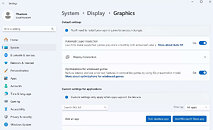T0@st
News Editor
- Joined
- Mar 7, 2023
- Messages
- 3,328 (3.99/day)
- Location
- South East, UK
| System Name | The TPU Typewriter |
|---|---|
| Processor | AMD Ryzen 5 5600 (non-X) |
| Motherboard | GIGABYTE B550M DS3H Micro ATX |
| Cooling | DeepCool AS500 |
| Memory | Kingston Fury Renegade RGB 32 GB (2 x 16 GB) DDR4-3600 CL16 |
| Video Card(s) | PowerColor Radeon RX 7800 XT 16 GB Hellhound OC |
| Storage | Samsung 980 Pro 1 TB M.2-2280 PCIe 4.0 X4 NVME SSD |
| Display(s) | Lenovo Legion Y27q-20 27" QHD IPS monitor |
| Case | GameMax Spark M-ATX (re-badged Jonsbo D30) |
| Audio Device(s) | FiiO K7 Desktop DAC/Amp + Philips Fidelio X3 headphones, or ARTTI T10 Planar IEMs |
| Power Supply | ADATA XPG CORE Reactor 650 W 80+ Gold ATX |
| Mouse | Roccat Kone Pro Air |
| Keyboard | Cooler Master MasterKeys Pro L |
| Software | Windows 10 64-bit Home Edition |
Microsoft has just announced that their new DirectSR Super Resolution API for DirectX will provide a unified interface for developers to implement super resolution in their games. This means that game studios no longer have to choose between DLSS, FSR, XeSS, or spend additional resources to implement, bug-test and support multiple upscalers. For gamers this is huge news, too, because they will be able to run upscaling in all DirectSR games—no matter the hardware they own. While AMD FSR and Intel XeSS run on all GPUs from all vendors, NVIDIA DLSS is exclusive to Team Green's hardware. With their post, Microsoft also confirms that DirectSR will not replace FSR/DLSS/XeSS with a new upscaler by Microsoft, rather that it builds on existing technologies that are already available, unifying access to them.
While we have to wait until March 21 for more details to be revealed at GDC 2024, Microsoft's Joshua Tucker stated in a blog post: "We're thrilled to announce DirectSR, our new API designed in partnership with GPU hardware vendors to enable seamless integration of Super Resolution (SR) into the next generation of games. Super Resolution is a cutting-edge technique that increases the resolution and visual quality in games. DirectSR is the missing link developers have been waiting for when approaching SR integration, providing a smoother, more efficient experience that scales across hardware. This API enables multi-vendor SR through a common set of inputs and outputs, allowing a single code path to activate a variety of solutions including NVIDIA DLSS Super Resolution, AMD FidelityFX Super Resolution, and Intel XeSS. DirectSR will be available soon in the Agility SDK as a public preview, which will enable developers to test it out and provide feedback. Don't miss our DirectX State of the Union at GDC to catch a sneak peek at how DirectSR can be used with your games!"



View at TechPowerUp Main Site | Source
While we have to wait until March 21 for more details to be revealed at GDC 2024, Microsoft's Joshua Tucker stated in a blog post: "We're thrilled to announce DirectSR, our new API designed in partnership with GPU hardware vendors to enable seamless integration of Super Resolution (SR) into the next generation of games. Super Resolution is a cutting-edge technique that increases the resolution and visual quality in games. DirectSR is the missing link developers have been waiting for when approaching SR integration, providing a smoother, more efficient experience that scales across hardware. This API enables multi-vendor SR through a common set of inputs and outputs, allowing a single code path to activate a variety of solutions including NVIDIA DLSS Super Resolution, AMD FidelityFX Super Resolution, and Intel XeSS. DirectSR will be available soon in the Agility SDK as a public preview, which will enable developers to test it out and provide feedback. Don't miss our DirectX State of the Union at GDC to catch a sneak peek at how DirectSR can be used with your games!"



View at TechPowerUp Main Site | Source







 Big bonus points here for the PC platform in the end.
Big bonus points here for the PC platform in the end.